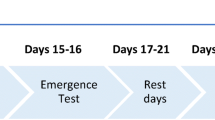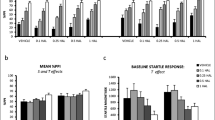Abstract
Male Roman low-(RLA) and high-avoidance (RHA) rats differ when tested in the elevated plus-maze and the black/white box, but not when (isolated and) tested for their social interaction. Herein, we have analysed the impact of prior isolation on male Roman rats tested in the first two models of anxiety; moreover, because central serotonin (5-HT) systems in Roman rats have been scarcely studied, we have also analysed several anxiety-related indices of central serotonergic activity in grouped/isolated Roman rats. Group-housed RLA rats tested in the elevated plus-maze and the black/white box were less anxious than their RHA counterparts, thereby confirming our previous study. Isolation had anxiogenic (and hypolocomotor) effects, these being significant in RLA rats only. Tryptophan hydroxylase activity in midbrain (but not in cortex, hippocampus or hypothalamus) was lower in group-housed (but not in isolated) RLA rats than in RHA rats, a difference independent from changes in the regulatory properties of the enzyme. Neither midbrain and hippocampal [3H]8-hydroxy-2-(di-n-propylamino)-tetrlin binding at 5-HT1A receptors, nor midbrain [3H] citalopram binding at the 5-HT transporter was different between grouped/isolated RHA/RLA rats. Alternatively, a trend toward a lower hypothalamic [3H]citalopram binding in (group-housed) RLA rats than in RHA rats could be noted, whereas cortical [3H]ketanserin binding at 5-HT2A receptors was lower in RLA rats than in RHA rats, a difference prevented by prior isolation. This study opens the possibility that inter-line differences in 5-HT2A receptors partly (or totally) underlie the respective behaviours of RHA and RLA rats in the elevated plus-maze and the black/white box.
Similar content being viewed by others
References
Ahmed SH, Stinus L, Le Moal M, Cador M (1995) Social deprivation enhances the vulnerability of male Wistar rats to stressor- and amphetamine-induced behavioral sensitization. Psychopharmacology 117:116–124
Andrews N, Hogg S, Gonzalez LE, File SE (1994) 5-HT1A Receptors in the median raphe nucleus and dorsal hippocampus may mediate anxiolytic and anxiogenic behaviours respectively. Eur J Pharmacol 264:259–264
Barrett JE, Vanover KE (1993) 5-HT receptors as targets for the development of novel anxiolytic drugs: models, mechanisms and future directions. Psychopharmacology 112:1–12
Benjamin D, Saiff EI, Nevins T, Lal H (1992) Mianserin-induced 5-HT2 receptor downregulation results in anxiolytic effects in the elevated plus-maze test. Drug Dev Res 26:287–297
Boadle-Biber MC (1982) Biosynthesis of serotonin. In: Osborne NN (ed) Biology of serotonergic transmission. John Wiley, New York, pp 63–94
Boadle-Biber MC, Corley KC, Graves L, Phan TH, Rosecrans J (1989) Increase in the activity of tryptophan hydroxylase from cortex and midbrain of male Fischer 344 rats in response to acute or repeated sound stress. Brain Res 482:306–316
Bradford MM (1976) A rapid and sensitive method for the quantitation of microgram quantities of protein-dye binding. Anal Biochem 72:248–254
Cadogan AK, Wright IK, Coombs I, Marsden CA, Kendall DA, Tulloch I (1992) Repeated paroxetine administration in the rat produces a decreased [3H]ketanserin binding and an anxiolytic profile in the elevated X-maze. Br J Pharmacol 107:108P
Castanon N, Dulluc J, Le Moal M, Mormède P (1992) Prolactin as a link between behavioral and immune differences between the Roman rat lines. Physiol Behav 51:1235–1241
Castanon N, Mormède P (1994) Psychobiogenetics: adapted tools for the study of the coupling between behavioral and neuroendocrine traits of emotional reactivity. Psychoneuroendocrinology 19:257–282
Chaouloff F (1993) Physiopharmacological interactions between stress hormones and central serotonergic systems. Brain Res Rev 18:1–32
Chaouloff F, Castanon N, Mormède P (1994) Paradoxical differences in animal models of anxiety among the Roman rat lines. Neurosci Lett 182:217–221
Chaouloff F, Kulikov A, Sarrieau A, Castanon N, Mormede P. Male Fischer 344 and Lewis rats display differences in locomotor reactivity, but not in anxiety-related behaviours:relationship with the hippocampal serotonergic system. Brain Res, in press
Charney Y, Steimer T, Huguenin C, Driscoll P (1995) [3H]Paroxetine binding sites: brain regional differences between two psychogenetically selected lines of rats. Neurosci Res Commun 16:29–35
Costall B, Jones BJ, Kelly ME, Naylor RJ, Tomkins DM (1989) Exploration of mice in a black and white box: validation as a model of anxiety. Pharmacol Biochem Behav 32:777–785
Coyle JT, Wender P, Lipsky A (1974) Avoidance conditioning in different strains of rats: neurochemical correlates. Psychopharmacologia 31:25–34
Crawley JN (1981) Neuropharmacologic specificity of a simple animal model for the behavioral actions of benzodiazepines. Pharmacol Biochem Behav 15:695–699
Cruz APM, Frei F, Graeff FG (1994) Ethopharmacological analysis of rat behavior on the elevated plus-maze. Pharmacol Biochem Behav 49:171–176
D'Amato R, Largent BL, Snowman AM, Snyder SH (1987) Selective labeling of serotonin uptake sites in rat brain by [3H]citalopram contrasted to labeling of multiple sites by [3H]imipramine. J Pharmacol Exp Ther 242:364–371
Driscoll P (1988) Hypothalamic serotonin turnover in rat lines selectively bred for differences in active, two-way avoidance behaviour. Adv Biosci 70:55–57
Driscoll P, Bättig K (1982) Behavioral, emotional and neurochemical profiles of rats selected for extreme differences in active, two-way avoidance performance. In: Lieblich E (ed) Genetics of the brain. Elsevier, Amsterdam, pp 95–123
Driscoll P, Dedek J, Martin JR, Baettig K (1980) Regional 5-HT analysis in Roman high- and low-avoidance rats following MAO inhibition. Eur J Pharmacol 68:373–376
Driscoll P, Dedek J, Martin JR, Zivkovic B (1983) Two-way avoidance and acute shock stress induced alterations of regional noradrenergic, dopaminergic and serotonergic activity in Roman high- and low-avoidance rats. Life Sci 33:1719–1725
Driscoll P, Lieblich I, Cohen E (1986) Amphetamine-induced stereotypic responses in Roman high- and low-avoidance rats. Pharmacol Biochem Behav 24:1329–1332
Fernandez-Teruel A, Escorihuela RM, Nunez JF, Goma M, Driscoll P, Tobena A (1992) Early stimulation effects on novelty-induced behavior in two psychogenetically-selected rat lines with divergent emotionality profiles. Neurosci Lett 137:185–188
Fernandez-Teruel A, Driscoll P, Escorihuela RM, Tobena A, Bättig K (1993) Postnatal handling, perinatal flumazenil, and adult behavior of the Roman rat lines. Pharmacol Biochem Behav 44:783–789
File SE (1980) The use of social interaction as a method for detecting anxiolytic activity of chlordiazepoxide-like drugs. J Neurosci Methods 2:219–238
File SE (1991) The biological basis of anxiety. In: Meltzer HY, Nerozzi D (eds) Current practices and future developments in the pharmacotherapy of mental disorders. Elsevier, Amsterdam, pp 159–165
File SE, Zangrossi Jr H, Andrews N (1993) Social interaction and elevated plus-maze tests: changes in release and uptake of 5-HT and GABA. Neuropharmacology 32:217–221
Gentsch C, Lichtsteiner M, Feer H (1981) Locomotor activity, defecation score and corticosterone levels during an openfield exposure: a comparison among individually and group-housed rats, and genetically selected lines. Physiol Behav 27:183–186
Gentsch C, Lichtsteiner M, Driscoll P, Feer H (1982) Differential hormonal and physiological responses to stress in Roman high- and low-avoidance rats. Physiol Behav 28:259–263
Gentsch C, Lichtsteiner M, Feer H (1983) Regional distribution of [3H]imipramine binding sites in the CNS of Roman high- and low-avoidance rats. Eur J Pharmacol 88:259–261
Giorgi O, Orlandi M, Escorihuela RM, Driscoll P, Lecca D, Corda MG (1994) GABAergic and dopaminergic transmission in the brain of Roman high-avoidance and Roman low-avoidance rats. Brain Res 638:133–138
Griebel G, Moreau JL, Jenck F, Misslin R, Martin JR (1994) Acute and chronic treatment with 5-HT reuptake inhibitors differentially modulate emotional responses in anxiety models in rodents. Psychopharmacology 113:463–470
Hamon M, Bourgoin S, Artaud F, El Mestikawy S (1981) The role of tryptophan uptake and tryptophan hydroxylase in the regulation of serotonin synthesis in the central nervous system. J Physiol (Paris) 77:269–280
Handley SL, McBlane JW (1993a) 5-HT drugs in animal models of anxiety. Psychopharmacology 112:13–20
Handley SL, McBlane JW (1993b) An assessment of the elevated X-maze for studying anxiety and anxiety-modulating drugs. J Pharmacol Toxicol Methods 29:129–138
Hyttel J (1994) Pharmacological characterization of selective serotonin reuptake inhibitors (SSRIs). Int Clin Psychopharmacol 9 [suppl 1]:19–26
Jankowska E, Pucilowski O, Kostowski W (1991) Chronic oral treatment with diltiazem or verapamil decreases isolation-induced activity impairment in elevated plus-maze. Behav Brain Res 43:155–158
Johnson AM (1991) The comparative pharmacological properties of selective serotonin re-uptake inhibitors in animals. In: Feighner JP, Boyer WF (eds) Selective serotonin re-uptake inhibitors — Perspectives in psychiatry. John Wiley, Chichester, pp 37–70
Kulikov AV, Kozlachkova EY, Popova NK (1992) The activity of tryptophan hydroxylase in brain of hereditary predisposed to catalepsy rats. Pharmacol Biochem Behav 43:99–103
Leysen JE (1992) 5-HT2 receptors: location, pharmacological, pathological and physiological role. In: Langer SZ, Brunello N, Racagni G, Mendlewicz J (eds) Serotonin receptor subtypes: pharmacological significance and clinical implications. Karger, Basel, pp 31–43
Lightowler S, Kennett GA, Williamson IJR, Blackburn TP, Tulloch IF (1994) Anxiolytic-like effect of paroxetine in a rat social interaction test. Pharmacol Biochem Behav 49:281–285
Lister RG (1990) Ethologically-based animal models of anxiety disorders. Pharmacol Ther 46:321–340
Maisonnette S, Morato S, Brandao ML (1993) Role of resocialization and of 5-HT1A receptor activation on the anxiogenic effects induced by isolation in the elevated plus-maze test. Physiol Behav 54:753–758
Marcusson J, Bäckström I, Ross SB (1986) Single-site model of the serotonin uptake and imipramine binding site. Mol Pharmacol 30:121–128
Motta V, Maisonnette S, Morato S, Castrechini P, Brandao M (1992) Effects of blockade of 5-HT2 receptors and activation of 5-HT1A receptors on the exploratory activity of rats in the elevated plus-maze. Psychopharmacology 107:135–139
Parker V, Morinan A (1986) The socially-isolated rat as a model for anxiety. Neuropharmacology 25:663–664
Pellow S, Chopin P, File SE, Briley M (1985) Validation of open: closed arm entries in an elevated plus-maze as a measure of anxiety in the rat. J Neurosci Methods 14:149–167
Popva NK, Voitenko NN, Kulikov AV, Avgustinovich DF (1991) Evidence for the involvement of central serotonin in mechanism of domestication of silver foxes. Pharmacol Biochem Behav 40:751–756
Rodgers RJ, Cole JC (1993) Influence of social isolation, gender, strain, and prior novelty on plus-maze behaviour in mice. Physiol Behav 54:729–736
Rodgers RJ, Shepherd JK (1993) Influence of prior maze experience on behaviour and response to diazepam in the elevated plus-maze and light/dark tests of anxiety in mice. Psychopharmacology 113:237–242
Roozendaal B, Wiersma A, Driscoll P, Koolhaas JM, Bohus B (1992) Vasopressinergic modulation of stress responses in the central amygdala of the Roman high-avoidance and low-avoidance rat. Brain Res 596:35–40
Schreiber R, De Vry J (1993) Neuronal circuits involved in the anxiolytic effects of the 5-HT1A receptor agonists 8-OH-DPAT, ipsapirone and buspirone in the rat. Eur J pharmacol 249:341–351.
Shephard RA, Broadhurst PL (1983) Hyponeophagia in the Roman rat strains: effect of 5-methoxy-N,N-dimethyltryptamine, diazepam, methysergide and the stereoisomers of propranolol. Eur J Pharmacol 95:177–184
Shephard RA, Nielsen EB, Broadhurst PL (1982) Sex and strain differences in benzodiazepine receptor binding in Roman rat strains. Eur J Pharmacol 77:327–330
Teiteler M, Leonhardt S, Weisberg EL, Hoffman BJ (1990) 4[125I]Iodo-(2,5-dimethoxy)-phenylisopropylamine and [3H] ketanserin labeling of 5-hydroxytryptamine2 (5-HT2) receptors in mammalian cells transfected with a rat 5-HT2 cDNA: evidence for multiple states and not multiple 5-HT2 receptor subtypes. Mol Pharmacol 38:594–598
Willig F, M'Harzi M, Bardelay C, Viet D, Delacour J (1991) Roman strains as a psychogenetic model for the study of working memory: behavioral and biochemical data. Pharmacol Biochem Behav 40:7–16
Wright IK, Crespi F, Marsden CA, Jones GH, Robbins TW (1989) Effect of isolation-rearing on 5-HT release in the frontal cortex. J Neurosci Methods 29:283
Wright IK, Ismail H, Upton N, Marsden CA (1991a) Effect of isolation rearing on 5-HT agonist-induced responses in the rat. Psychopharmacology 105:259–263
Wright IK, Upton N, Marsden CA (1991b) Resocialisation of isolation-reared rats does not alter their anxiogenic profile on the elevated X-maze model of anxiety. Physiol Behav 50:1129–1132
Zhukov DA, Vinogradova KP (1994) Inescapable shock induces the opposite changes of the plus-maze test behavior in rats with divergent coping strategy. Physiol Behav 56:1075–1079
Author information
Authors and Affiliations
Rights and permissions
About this article
Cite this article
Kulikov, A., Castanon, N., Mormède, P. et al. Cerebral tryptophan hydroxylase activity, and 5-HT1A receptor, 5-HT2A receptor, and 5-HT transporter binding in grouped and isolated Roman RHA and RLA rats: relationships with behaviours in two models of anxiety. Psychopharmacology 121, 385–395 (1995). https://doi.org/10.1007/BF02246079
Received:
Revised:
Issue Date:
DOI: https://doi.org/10.1007/BF02246079




